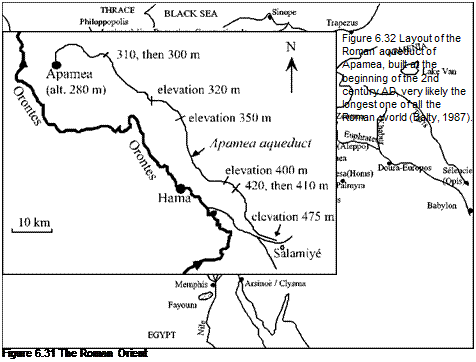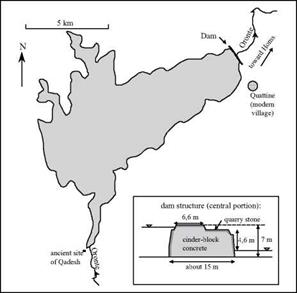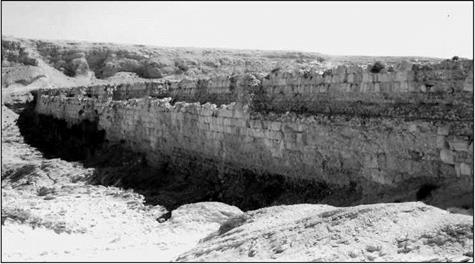Development of the Roman Orient
During the last years of the Republic, Greece, Anatolia, Syria-Palestine, Egypt, and Cyrenaica had become Roman. This process began with the bequeathing of Pergamon to the Roman Republic, and was marked by Augustus’ taking possession of Egypt in 31 BC, and continuing through the tumult of the many wars during the last years of the Republic. There is not much to say of Greece, for she was knocked flat by wars and never got back on her feet economically. The reader may recall the development works at lake Copais undertaken in the Mycenaean era (Figure 4.10), and somewhat restored by Alexander the Great. Several sources mention that during the Roman period the lake’s dikes are no longer maintained, that the adjacent cities are subject to flooding, and that the best land must be abandoned.[273]
Other lands of the Orient fare differently. Trajan reaches the Persian Gulf in 116 AD after having conquered the Parthians, but in the end Rome is able to hold onto only the extreme northwest of Mesopotamia. Thereafter, the Orient provides Rome with emperors: Septimus Severus marries the daughter of the sun-god priest at Homs (Emesa), and his son Caracalla is therefore half Syrian. His successors, Elagabal and Severus Alexander, from the maternal side of Caracalla’s family, are entirely Syrian. In the middle of the 3rd century AD, when the Empire is threatened along all of its borders, the Sassanide Persians reach Antioch and, to add to the humiliation, take the Emperor Valerius and all of his army as prisoners, in 260 AD. At Palmyra, queen Zenobia seizes the opportunity to launch offensive military expeditions, taking Alexandria in 270 AD. But in 272 AD the new Emperor Aurelius retakes control of all of the Roman Orient, and it remains peaceful for an extended period. Diocletius begins to create an autonomous Roman Orient, in dividing political power among four emperors and establishes his own capital at Nicomedia, near Byzantium. In 330 AD the Emperor Constantine takes personal control of all of the Empire, but especially favors the Orient and transforms the Greek city Byzantium into Constantinople, the new capital of the Orient. When Rome falls in 410 AD, the Roman Orient remains standing.
Egypt is arguably the least Roman of the lands of the Empire, and it retains its identity under Roman domination. Its governance continues under the Ptolemaic tradition, though the peasants are under increasingly oppressive fiscal pressure. Over and above direct taxation, they must meet a number of other obligations. Just as in the Ptolemite period (and also probably in the Pharaonic era), they are obliged to work on maintenance of the dikes.[274] During the time of the Pharaohs, Egypt had only to feed herself. But under the Ptolemites, she must in addition produce the surpluses necessary for the grand political ambitions of her leaders. Then under the Romans, Egypt must also feed the great cities of the Empire (and the city of Rome first and foremost), a heavy burden shared with only a few other provinces such as Numid.
In response to these needs, the Egyptians further develop the Fayoum irrigation system – dropping the lake level down to its present level to reclaim additional land, and cleaning out the canals. Moreover, they maintain the qanats that had been constructed by the Persians in the Kharga oasis and even build new ones. The small oases of Dakhla, Farafra, and Baharya to the north of Kharga appear to have flourished during the Roman period, and this success is likely attributable to the qanats built by the Romans.[275] According to Henri Goblot, it is indeed in Egypt that the Romans learned how to build these very special devices.
The city of Alexandria continues to be a great intellectual center under the Romans, as we have seen in Chapter 5. Alexandria is a cosmopolitan city with a population of some half million,[276] and it is in a state of constant turbulence. It is said that Carcalla, the son of Septimus Severus, had the sword taken to all the young people of the city in the spring of 215 AD after they had publicly criticized him.
Some fifteen Roman dams are found in the Orient – in Anatolia, Syria-Palestine and in the northwest of Mesopotamia. Other hydraulic works are to be built by the Byzantines after the fall the Occidental Roman Empire. The structure thought to be the oldest has a very specific purpose. It is 16 m high and 60 m long (but only 5 m wide, and therefore of precarious stability), and was built in 80 AD to divert floodwaters and protect the port of Antioch on the Orontes.[277] Antioch is the ancient capital of the Seleucids and an opulent capital of the Roman province of Syria.
Earlier in this Chapter we mentioned some of the aqueducts built in the Orient, like the one at Apamea on the Orontes (Figure 6.32), perhaps the longest of all those in the Roman Empire. The water supply of Jerusalem (Aelia Capitolina from Hadrian) is one of the most famous ones of the Orient, given its symbolic importance. The pools of Solomon, vast reservoirs 13 km south of Jerusalem that are created by dams, store
200,0 cubic meters of water. An aqueduct begins at a reservoir situated near Hebron, connects this reservoir to the pools of Solomon, and then continues to Jerusalem, passing through the center of Bethlehem, very close to the Cave of the Nativity. These installations have often been incorrectly attributed to King Solomon. In fact, they should be attributed to the Roman governor Pontius Pilate, at the very beginning of the
 |
Christian era.
Other hydraulic projects were built for the storage of irrigation water. Two of them, both located in Syria, merit our attention.
On the Orontes there is a very large lake formed by a dam built around 1935 over
the remains of a famous ancient dam, 12 km southwest of Homs (the Roman Emesa).[278] In Antiquity, this dam served the same function of maintaining the lake of Homs (at a level three meters lower than the modern dam). According to the study conducted in 1921 by Louis Brosse, the dam was 850 m long[279] and at most seven meters high. The dam is very stable thanks to its broad width, 15 to 20 m in its central portions. Four overflow weirs, two each on the right and left banks, carry water to canals that lead to the city of Homs and agricultural zones.
A curious feature of this installation is that when the dam was first built, the normal course of the Orontes downstream of the dam is not supplied by water from the spillway, but rather by copious percolation through the face of the dam itself, a face obviously not at all watertight. Modern observers attribute this dam to the Roman period, based on its architecture of a fill of rough-stone concrete between walls of quarry stone. More precisely, the dam appears to date from the year 284 AD, first year of the reign of Diocletius. The dam reflects the prosperity of the city of Emesa at this time.
But these same observers used to believe, in the 1980s, that the dam was much older, having been constructed by the Pharaoh Sethi I, in the 13th century BC, when Egypt dominated this region. The very ancient city of Qadesh was the site of a famous battle between Egyptians and Hittites. One must also consider the account of Strabo, who situated one of the sources of the Orontes near the “Egyptian wall, toward the territory of Apamea.”[280] This account clearly refers to the phenomenon of the Orontes flowing directly from infiltration through the wall of the dam. The most reasonable hypothesis,
 Figure 6.33 The lake of Homs (in 1932), a reservoir of about 90 million m3, and the structure of the ancient dam, after the measurements of L. Brosse in 1923 (Calvet and Geyer, 1992).
Figure 6.33 The lake of Homs (in 1932), a reservoir of about 90 million m3, and the structure of the ancient dam, after the measurements of L. Brosse in 1923 (Calvet and Geyer, 1992).
following Yves Calvet and Bernard Geyer, is that the site of the dam is a natural rocky barrier which, from very early times of Antiquity, was the site of structures built to raise the level of the natural lake. It is therefore probable that the Romans reconstructed or renovated an ancient dam at the time of Diocletius, following local rather than Egyptian practices, much as the modern dam is constructed over the Roman structure. The long life of the dam, and the fact that the impoundment is not filled with sediment, could be explained by the regular flow of the Orontes.
The Orontes is obviously a river that invites the development of hydraulic works, and it continues to do so as we discuss later in Chapter 7. But there is another region whose development necessitates important hydraulic projects: the region of Palmyra, a land of oases in the middle of the harsh desert of Syria, stopover of caravans on the silk road. Many small oases of Palmyra owe their prosperity to qanats. These could have been constructed by the Persians during the time of the Achaemindes Empire, but it is certain that the network of qanats is further developed and maintained by the Romans.[281] Even more spectacular in this region is the dam of Harbaqa, another project whose purpose is to create a reservoir of water for irrigation. The dam is constructed on a seasonal watercourse, the wadi al-Barda, 70 km southeast of Palmyra.[282] With its height of 21 m and its length of 365 m, this is the largest dam of the Roman world (except possibly for the dam of Nero at Subiaco, which is higher). It constitutes a rectilinear wall whose thickness at the base is 18 m, further reinforced with buttresses. It is undoubtedly thanks
|
Figure 6.34 In a land of minerals, the dam of Harbaqa across the valley of a Wadi. The impoundment is today completely filled in, but the dam enables the fill to retain sufficient moisture for farming. View from downstream (photo by the author). |
to this solid construction that the dam remains standing today, minor repairs having been effected during the 1960’s (Figure 6.34). The dam was apparently built at the end of the 1st century or the beginning of the 2nd century AD as part of the infrastructural work ordered by Hadrian, who visited Palmyra in 130 AD. Much later, under the Umeyyades, new hydraulic works were built downstream of the dam of Harbaqa (Figure 7.10).
In closing this overview of hydraulic technology used in the Roman Orient, we must mention the technical consequences of a serious Roman defeat. When the Emperor Valerius is taken prisoner by the Sassanide Persians in 260 AD, the civil-engineering competence of the captured army is used to build several multi-purpose structures comprising a dam-spillway and a bridge near the capital city Suse, on the Karun River and its tributaries. This was a kind of forced technology transfer.







Leave a reply